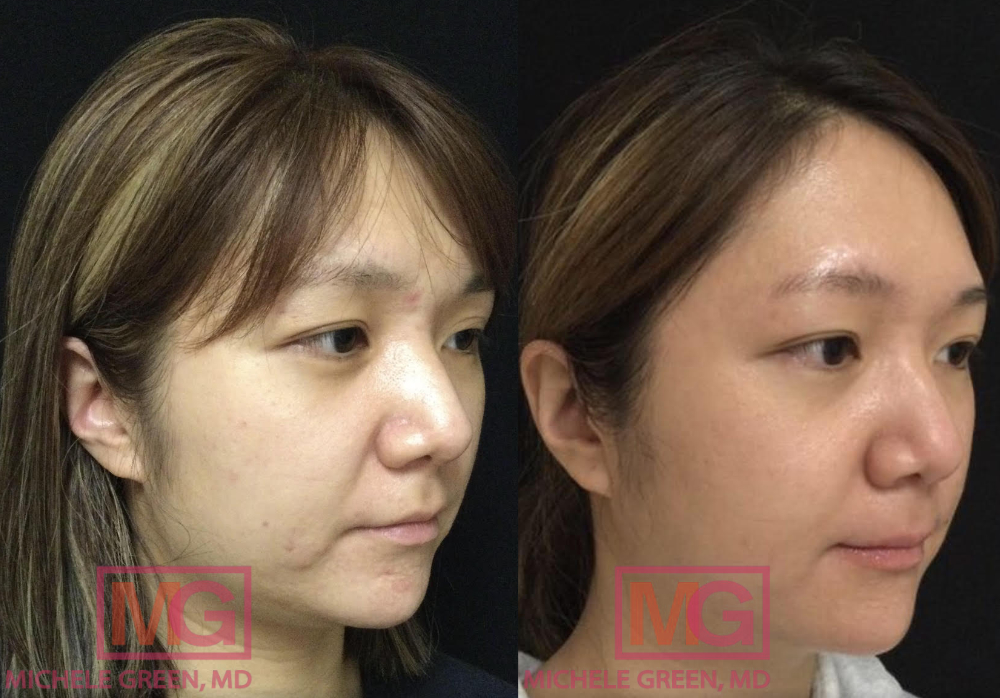Acne Laser Treatment NYC
Active acne breakouts and scars on the face can negatively impact one‘s self-confidence and self-esteem. Each year, up to 50 million Americans are affected by acne, and one in five individuals with breakouts is estimated to develop scars. Fortunately, advancements in cosmetic dermatology have introduced laser treatments that utilize various forms of light or energy to eliminate acne lesions and diminish the appearance of scars. With numerous laser treatment options available, choosing the best ones suited to your specific skin condition can feel overwhelming. With the assistance of expert NYC board-certified dermatologist Dr. Michele Green, it is possible to eliminate acne and scars from the skin, achieving a smooth, healthy, and radiant complexion.
Acne laser treatments can effectively address active acne lesions and scars for patients of all skin types and tones. These treatments provide highly safe, long-lasting results with minimal to no downtime or side effects. For optimal cosmetic outcomes, it’s advisable to treat active acne lesions first to prevent further scarring. The Acleara, Photodynamic therapy, and VBeam lasers are all excellent options for reducing acne-causing bacteria and oil production to clear breakouts. Subsequently, lasers like Fraxel, Clear + Brilliant, eMatrix, or VBeam can be used to address remaining acne scars. Dr. Green often employs a combination approach to treating acne and scars, assessing your skin to create a personalized plan and selecting the most effective laser treatments to ensure you achieve clear, radiant skin that lasts.
Dr. Michele Green is an internationally recognized, board-certified dermatologist with over 25 years of experience providing some of the world’s most discerning individuals with cutting-edge, non-invasive options for acne and acne scarring laser treatments. As an expert cosmetic dermatologist, Dr. Michele Green utilizes the latest modalities to treat acne scars and breakouts, including laser treatments such as VBeam, Fraxel, and eMatrix. She is consistently acknowledged as one of New York’ s top dermatologists by Castle Connolly, New York Magazine, and Super Doctors for her commitment to her patients and expertise. When you consult with Dr. Green to address breakouts and reduce the appearance of acne scars, she will work with you to develop a personalized treatment plan tailored to your unique skin condition, aesthetic goals, and skin type.
What is acne? What causes it?
Acne vulgaris, commonly referred to as acne, is a skin condition that arises when the oil glands in the skin’s pores become clogged with dead skin cells, excess sebum, and other debris. Sebum is a natural oil that helps keep the skin soft and moisturized. When excessive sebum is produced, it can become trapped in the oil glands along with debris and bacteria, resulting in inflammation, redness, and pain. Acne is prevalent during adolescence but can develop at any stage of life. It commonly appears on the forehead, chin, nose, upper back, and shoulders, although it can occur anywhere oil glands are present. Various factors, including genetics, overactive oil glands, bacterial infections, hormones, diet, stress, and specific medications, can trigger pimples. If left untreated or poorly managed, acne can lead to permanent scarring or hyperpigmentation. If you are experiencing active acne breakouts, it is vital to consult a board-certified dermatologist like Dr. Green as soon as possible to address the acne before any scars develop.
Why consult with a dermatologist for acne treatment?
Consulting with a board-certified dermatologist should be the first step for patients struggling with any form of acne, whether mild or moderate to severe. Rapid and effective treatment of breakouts is crucial to prevent the development of acne scars, which are often more challenging to treat than the initial acne breakout. If you have a family history of acne, are experiencing inflammatory acne that is starting to cause scars, or have persistent acne that does not respond to over-the-counter treatments, you should seek the expertise of board-certified dermatologist Dr. Green. Depending on the underlying cause and type of acne, potential treatments may include oral antibiotics, topical medications such as antibiotics and retinoids, Accutane, chemical peels, laser treatments, and HydraFacial. If you have tried various topical and oral medications but are still dealing with active breakouts or scarring, Dr. Green may recommend Accutane therapy. Accutane is recognized as the gold standard for treating resistant acne and preventing scars and hyperpigmentation. Once your active acne is completely resolved, you can begin addressing your acne scars effectively. It’s important to note that Isotretinoin therapy may delay your laser treatments for acne scarring by six months. Once your breakouts are under control, Dr. Green can create a personalized treatment plan tailored to your specific acne scars, helping you achieve clear, radiant skin.
Is laser treatment for acne effective?
Yes! Laser treatment has been clinically proven to reduce active acne, and various laser technologies are suitable for patients of different skin tones and types. Acne laser treatments, such as Vbeam and Photodynamic therapy, have been shown to reduce up to 90% of acne lesions in a treatment area with long-lasting results. An expert board-certified dermatologist like Dr. Green in NYC has the experience to recommend the laser treatments best suited to you and your specific skin condition, helping you avoid unwanted side effects and achieve optimal rejuvenation results.
How does laser acne treatment work?
Laser treatments can address active acne by inhibiting the growth of bacteria that cause acne on the skin’s surface or reducing the activity of sebaceous glands. Two effective treatments for acne include photodynamic therapy and the Vbeam laser. The most suitable laser treatment for your acne depends on the type and severity of your condition as well as your skin type. When you consult with Dr. Green in her private NYC dermatology office, she will work with you to develop a customized treatment plan to clear your acne breakouts.
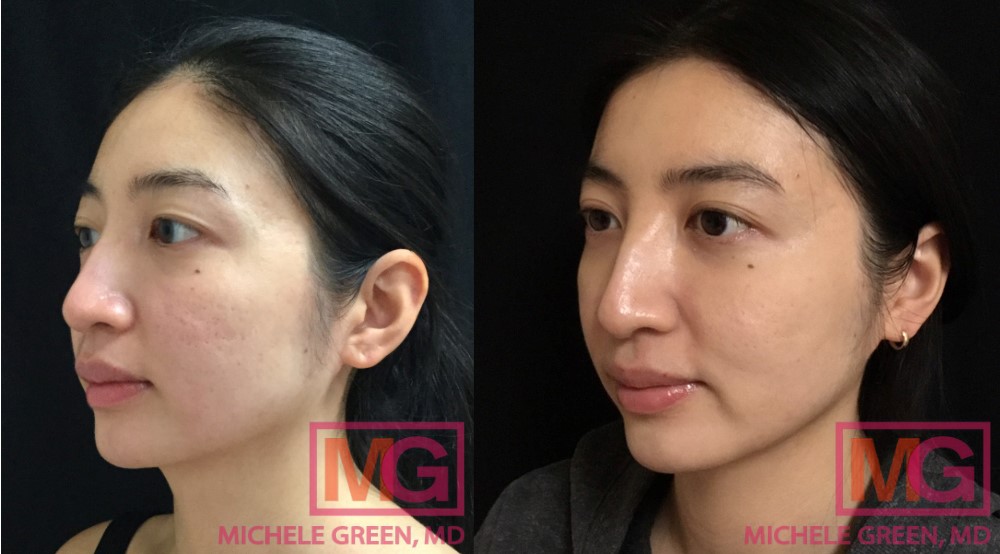
3 eMatrix treatments and 3 vbeam laser treatments
Types of laser treatment options available for acne
Acleara Laser for acne
The Acleara laser is a new cosmetic procedure that utilizes intense pulsed light (IPL) and vacuum technology to address acne breakouts. The filtered broadband light eliminates acne-causing bacteria and reduces oil production on the skin’s surface. At the same time, the vacuum removes the buildup of dead skin cells, bacteria, debris, and excess oils from the pores. Furthermore, Acleara’s light technology helps decrease inflammation and redness. Treatment with the Acleara laser is not painful and requires no downtime. Although the Acleara laser is excellent for treating mild to moderate acne lesions, it is costly and not a permanent solution, necessitating multiple treatments to achieve and sustain optimal results.
Photodynamic Therapy (PDT) acne laser treatment
Photodynamic therapy is a non-invasive treatment option for various conditions, including active acne, skin cancer, precancerous lesions, psoriasis, and age-related macular degeneration. Also known as PDT, this therapy effectively treats acne by reducing the size of the sebaceous glands, limiting sebum production, and eliminating acne-causing bacteria. The PDT process consists of two parts: first, a topical photosensitizer chemical sensitive to a specific wavelength of light is applied to the treatment area. In the second part, the targeted wavelength of light activates the photosensitizer at the treatment site. Once the photosensitizing agent is activated by exposure to light, it generates oxygen radicals that destroy the targeted cells that have absorbed the agent. Various sources of PDT light are available, including lasers, intense pulsed light, blue light, red light, and visible light, such as natural sunlight. It is highly recommended to avoid direct light or sunlight in the treatment area for 24 to 72 hours following your Photodynamic Therapy procedure. Typically, a series of three to five Photodynamic Therapy treatments is conducted at four-week intervals. Dr. Green will determine the number of sessions needed during your consultation, which will depend on the severity of your condition acne.
Vbeam Laser acne treatment
The Vbeam laser is clinically proven to treat inflammatory acne lesions and reduce the appearance of acne scars. This laser treatment operates at a wavelength of 595 nm, effectively killing acne-causing bacteria, reducing inflammation, and eliminating red pigment from the skin. Additionally, this laser therapy can target various skin conditions, such as rosacea, stretch marks, broken capillaries, and post-inflammatory hyperpigmentation, which is a form of skin discoloration often left after acne lesions heal. Most patients require four to six Vbeam laser treatments, spaced four weeks apart, to achieve optimal results. The Vbeam laser features a patented Dynamic Cooling Device that emits a burst of cool air before each pulse of the laser beam, enhancing patient comfort during the procedure. Moreover, the treatment involves no downtime, allowing patients to easily schedule their sessions.
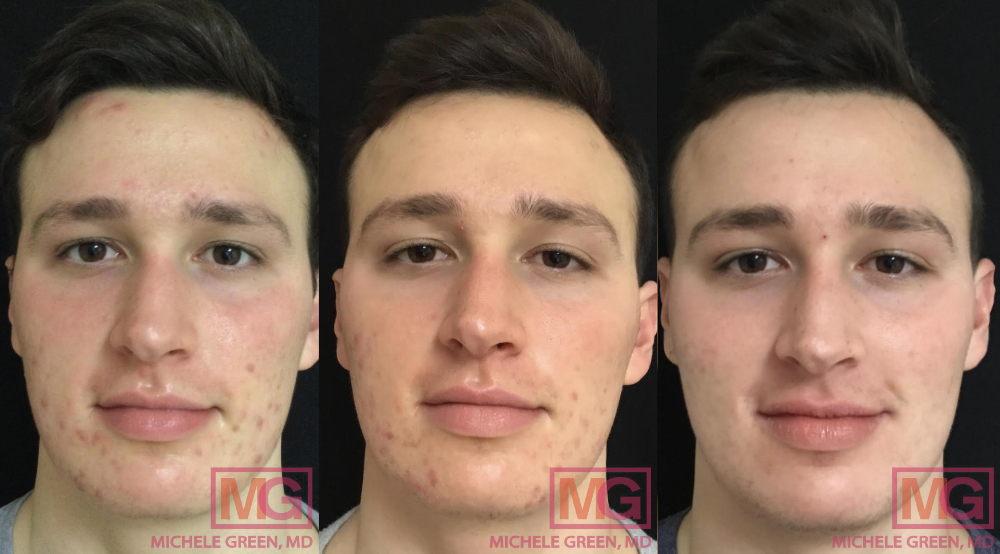
What are the side effects of laser acne treatment?
The side effects of acne laser treatment can vary depending on the type of laser used. However, common side effects typically include temporary redness, swelling, and tenderness in the treated area. Generally, these side effects are mild and resolve on their own shortly after treatment. Some patients with a history of cold sores may experience a breakout post-laser treatment, as any trauma to the skin can trigger a flare-up. If you have a history of Herpes Simplex Virus, Dr. Green will prescribe a prophylactic dose of Valtrex to help prevent an outbreak. After the procedure, the treatment area may be more sensitive to light, so it’s crucial to protect it from sun exposure to achieve and maintain optimal results while guarding against UV damage. When undergoing laser treatment with Dr. Green at her private dermatology office in Manhattan’s Upper East Side, you will receive all the essential aftercare information needed to ensure the best results.
How do I prepare for laser treatment?
Ahead of an appointment for acne scar or acne laser treatment, Dr. Green recommends that her patients adhere to the following guidelines:
- Avoid tanning or self-tanners for several weeks before treatment.
- Refrain from smoking for at least two weeks before treatment.
- Discontinue chemical peels or topicals that could increase skin sensitivity, such as Retin-A or Retinols, glycolic acid, and salicylic acid, for at least one week before treatment.
- Pre-treat with Valtrex if you have a history of oral herpes or cold sores.
What to do after acne laser treatment?
The recovery time after acne laser treatment varies based on the specific type of laser used. Patients may experience mild redness, swelling, and tenderness during this period, but these symptoms usually resolve on their own within a few days. To prevent additional irritation, patients should refrain from using exfoliating products and should apply generous amounts of moisturizer and sunscreen. After Photodynamic Therapy, patients are advised to avoid direct light or sunlight for one to three days to prevent reactivating the photosensitizing drug. The Vbeam laser requires no downtime, allowing patients to resume their daily activities immediately following the procedure. Before your acne laser treatment, Dr. Green will review all potential side effects and aftercare instructions to ensure you are well-informed well-prepared.
Will laser treatment remove acne scars?
There are various types of acne scars, including atrophic scars such as boxcar, rolling, and icepick scars, as well as hypertrophic scars like keloids. Treating atrophic scars involves minimizing scar depth and resurfacing the skin’s texture. Laser treatment stimulates collagen and healthy skin cell production, which are essential for replacing scar tissue and enhancing overall skin rejuvenation. Atrophic acne scars can be treated with laser therapy, subcision with dermal fillers, or microneedling, which boosts collagen production and evens out the skin texture.
Acne Scar Laser Treatments
Fraxel – Fractional Non-ablative Laser Treatment
The Fraxel laser is regarded as the gold standard for fractionated laser resurfacing. Dr. Green often refers to it as the ‘magic eraser’ due to its unique ability to target various skin conditions. The Fraxel laser treatment operates on two distinct wavelengths: the 1927 nm wavelength addresses sunspots, hyperpigmentation, and other forms of skin discoloration, while the 1550 nm wavelength smooths skin texture, reduces the appearance of fine lines, and helps eliminate acne scars. As a non-ablative and fractionated laser treatment, Fraxel creates microscopic laser columns that penetrate deep into the skin, leaving the top layer of skin intact and preserving the skin surrounding the treated area. The energy stimulates collagen production in the dermis, resulting in smoother skin texture. Most patients require a series of three to five Fraxel laser treatment sessions, each spaced approximately one month apart, to achieve optimal results in acne scar reduction. After treatment, patients will experience redness and mild swelling, which typically resolve within 48 hours. It is crucial to use proper sun protection post-treatment, applying a broad-spectrum sunscreen with an SPF of 50 and minimizing sun exposure, as the Fraxel laser increases skin sensitivity to the sun.
eMatrix Laser – Non-ablative Laser Treatment
The eMatrix laser is a non-ablative resurfacing treatment that uses bipolar radiofrequency energy to heat the skin beneath the surface, stimulating collagen production, reducing acne scars, and generating younger, healthier-looking skin cells. The eMatrix laser effectively delivers heat directly to the deeper layers of the dermis while bypassing the upper layer of skin, leaving it unharmed. This method allows for accelerated healing, minimal downtime, and a lower risk of adverse side effects typically associated with more ablative lasers, such as scarring or hyperpigmentation. The eMatrix laser is safe and effective for all skin types and is regarded as the gold standard for treating acne scars in Asian patients and individuals with darker skin tones. A series of four to six monthly eMatrix treatments is generally necessary to achieve optimal cosmetic results. Common side effects from eMatrix laser treatment include mild redness and peeling, which typically resolve on their own within 48 hours after the procedure. In the months following eMatrix treatment, collagen production will continue to improve the skin, leading to a diminished appearance of depressed acne scars.
Clear and Brilliant Laser
The Clear and Brilliant laser, also known as the “mini-Fraxel,” is an excellent option for patients seeking skin rejuvenation benefits from fractionated laser treatment without any downtime. This gentle fractional laser technology allows for the treatment of specific areas of the face, producing smooth and even results without redness or recovery time. It can improve skin texture from acne scars and enhance uneven skin tone caused by sun damage or hyperpigmentation, requiring only 5 to 6 sessions spaced three to four weeks apart. Dr. Green uses the Clear and Brilliant laser along with the Permea handpiece, which is specifically designed to address sun damage, pigmentation, and melasma. Patients with deeper acne scars may benefit from additional laser treatments, such as Fraxel or eMatrix, which can penetrate the dermal layer of the skin. Sunblock and topical Vitamin C are advised after laser treatment to maximize cosmetic results.
Vbeam Laser
The Vbeam® laser is recognized as the “gold standard” for treating facial redness, broken blood vessels, and rosacea. This pulsed dye laser delivers concentrated light energy directly to the target area without damaging the surrounding tissue. Ideally, treatments should be scheduled monthly, with 4 to 5 sessions to significantly reduce redness caused by acne and acne scars. The Vbeam laser is particularly effective for treating keloid or raised scars. By targeting the vascular components of raised scars, the laser can effectively diminish both the color and size of keloids. There is no downtime associated with the Vbeam laser treatment, which can be completed in just 15 minutes during your lunch break. Additionally, the laser features a patented Dynamic Cooling Device that releases a burst of cool air before each pulse, enhancing patient comfort throughout the treatment. The Vbeam is also highly effective in treating hemangiomas, leg veins, stretch marks, angiomas, inflammatory acne lesions, and surgical scars scars.
Intense Pulsed Light (IPL)
Intense pulsed light (IPL) therapy, also known as a photo facial, is a technique for improving skin redness, pigmentation, and texture. Unlike lasers that use a single wavelength of light, IPL can utilize multiple wavelengths of pulsating light to target various skin conditions at once. It effectively addresses redness, hyperpigmentation, and discoloration from acne scars while stimulating collagen production for smoother skin. Photopneumatic therapy is a unique treatment that combines IPL with suction vacuum technology to treat active acne. The light therapy aspect of IPL destroys acne-causing bacteria, while the suction component removes debris, sebum, and dead skin cells from the pores.
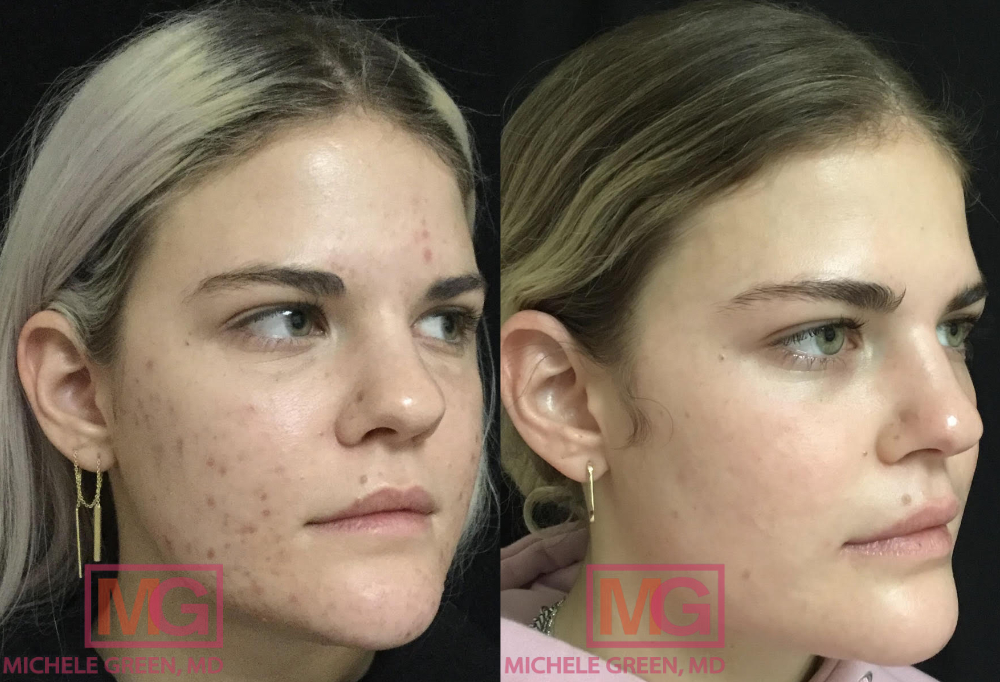
Additional Acne Scar Treatments
Subcision with Dermal Fillers
Subcision with dermal fillers effectively treats atrophic acne scars by breaking down scar tissue and restoring lost volume to the area. During the procedure, a needle disrupts the scar tissue responsible for the depressed acne scars. When subcision is conducted with dermal fillers, the filler is injected directly into the indented acne scar to immediately provide a smoother skin surface. Dr. Green often performs subcision using Sculptra or hyaluronic acid dermal fillers to achieve optimal cosmetic results with no downtime. Dr. Green’s unique technique of subcision and injection can enhance the appearance of scars even after just one treatment.
Sculptra is a specialized dermal filler composed of poly-L-lactic acid, which stimulates collagen production. As collagen forms over time, skin texture improves, reducing the visibility of depressed acne scars. Patients typically require a series of three Sculptra treatment sessions to achieve the best results, which can last for up to two years. Many patients also engage in regular follow-up treatments to maintain optimal results. Dermal fillers like Juvederm and Restylane contain hyaluronic acid, a naturally occurring substance in the skin that supports hydration and a youthful appearance. These fillers are often employed to restore volume lost due to acne scars, enhancing skin smoothness. The effects of hyaluronic acid fillers are immediate and can last between six and twelve months.
Microneedling
Microneedling, also known as collagen induction therapy, serves as an alternative to laser treatment for acne scarring. This technique creates micro-channels in the skin, prompting the body’s wound-healing response to generate new collagen. Microneedling refines the skin, reducing the visibility of acne scars, fine lines, and wrinkles while enhancing skin tone and texture. Additionally, it promotes better penetration of topical products and is often combined with platelet-rich plasma (PRP) to improve results. PRP contains growth factors and proteins that speed up healing, support tissue repair, and boost collagen synthesis. As PRP is derived from a patient’s blood sample, it is completely natural and maximizes the aesthetic benefits of the microneedling procedure, effectively diminishing acne scars and fostering healthy, glowing skin skin.
Vivace microneedling
Vivace microneedline is a non-invasive treatment option that combines two modalities: microneedling and radio frequency (RF) energy. Microneedling involves the application of a handheld device containing tiny, sterile needles to the skin’s surface. As the device is passed along the skin, small microchannels are created, jump-starting the body’s natural healing process and increasing collagen synthesis. At the same time, Vivace delivers radiofrequency energy that is converted into heat to induce collagen synthesis. Vivace is an excellent acne scar treatment option, as microneedling stimulates new collagen production in the epidermis, and radiofrequency energy simultaneously stimulates collagen production in the dermis, maximizing the cosmetic results seen after the procedure. By replenishing collagen levels in the treated area, Vivace is able to create a smoother skin texture and reduce the appearance of acne scars. The exact number of treatments an individual needs will ultimately depend upon their specific needs and goals. For optimal results, Dr. Green recommends patients engage in at least three Vivace treatments, each spaced four weeks apart. Some patients experience mild redness in the treatment area, which resolves independently within 24 hours of their Vivace treatment.
What are the side effects of laser treatment for acne scars?
Some of the most common side effects of laser treatment for acne scars include mild redness, swelling, and discomfort. These effects typically resolve on their own within 48 hours after treatment, depending on the specific laser used. After the procedure, the skin becomes more sensitive to sunlight, making it essential to use sunscreen and limit sun exposure to prevent hyperpigmentation and further redness. Other possible side effects include hyperpigmentation, hypopigmentation (white spots), skin infections, and scarring. The risk of experiencing these adverse side effects is reduced when seeking laser treatment from an experienced, board-certified dermatologist, such as Dr. Michele Green in NYC. It is always advisable to consult a healthcare professional with expertise in laser procedures, rather than inexperienced or unqualified providers in a medical spa setting, to ensure safety, efficacy, and optimal results for skin rejuvenation. Non-ablative laser treatments, which Dr. Green offers at her private boutique dermatology office in Manhattan’s Upper East Side neighborhood, involve fewer potential side effects and significantly less downtime.

FAQs about Acne and Acne Scar Laser Treatment
Which laser treatment is best for acne scars?
Acne breakouts are not identical, nor are the scars they leave behind. The best type of laser for eliminating your acne scars ultimately depends on your scar and skin type. Lasers like Fraxel are not safe for all skin types, and when used incorrectly, they can lead to hyperpigmentation and scarring. The most effective way to determine which laser resurfacing treatment is best for your acne scars is to consult a board-certified cosmetic dermatologist, such as Dr. Michele Green in NYC. Dr. Green has over 25 years of experience providing discerning men and women around the world with treatments for acne and acne scars, resulting in smooth, clear, healthy, beautiful skin that lasts. It’s essential to choose a provider you trust for your laser skin resurfacing treatment for acne scar removal, as using the wrong laser type or settings can lead to unwanted cosmetic effects. Whether your acne scar removal treatment involves sessions with Fraxel Dual laser, V-Beam, eMatrix, Clear and Brilliant, or another non-invasive laser resurfacing treatment, Dr. Green is your expert guide to finding the right combination of treatments for you.
Do acne lasers actually work?
Yes! Various lasers can effectively reduce the appearance of acne breakouts by eliminating acne-causing bacteria and decreasing the size of the sebaceous glands. The sebaceous gland produces sebum, and in many cases, excess sebum leads to bacteria and debris becoming trapped in the pores, resulting in acne lesions. Acne laser treatment can lower the sebum and bacteria on the skin, ultimately clearing up acne. Dr. Michele Green is a board-certified cosmetic dermatologist in NYC with the experience and expertise necessary to tailor your acne treatment for the best results. She will ensure that the treatment addresses your specific skin concerns, including acne and acne scars, effectively and efficiently.
How many sessions of laser acne treatment are needed?
Typically, multiple laser treatment sessions are necessary to address acne lesions. Depending on the type of laser, as well as the severity and nature of the acne, anywhere from three to six sessions may be required. While laser treatments can yield long-lasting results, some patients may need maintenance sessions to maintain consistently clear skin. Laser treatment sessions are typically scheduled four weeks apart to allow the skin sufficient time to heal between treatments.
Will laser treatment get rid of acne permanently?
Acne laser treatments provide long-lasting results, and for some, they can be permanent; however, others may require annual maintenance sessions to maintain consistently clear skin. Certain types of light therapy and laser treatments effectively target active acne breakouts. Blue light and red light therapies are FDA-approved for treating acne. However, visible light treatments are not effective against acne cysts, blackheads, whiteheads, and nodules. Photodynamic therapy is a viable option for moderate to severe acne treatment. During your consultation with board-certified dermatologist Dr. Michele Green, she will gather a comprehensive medical history, including any family history of acne, review your skincare routine, and discuss any previous acne treatments you’ve undergone. Blood tests may be requested to identify any underlying factors contributing to your breakouts. Dr. Green will then collaborate with you to create a personalized acne treatment plan that includes effective laser therapies, helping you prevent acne scars and achieve a smooth, clear, and healthy complexion that lasts.
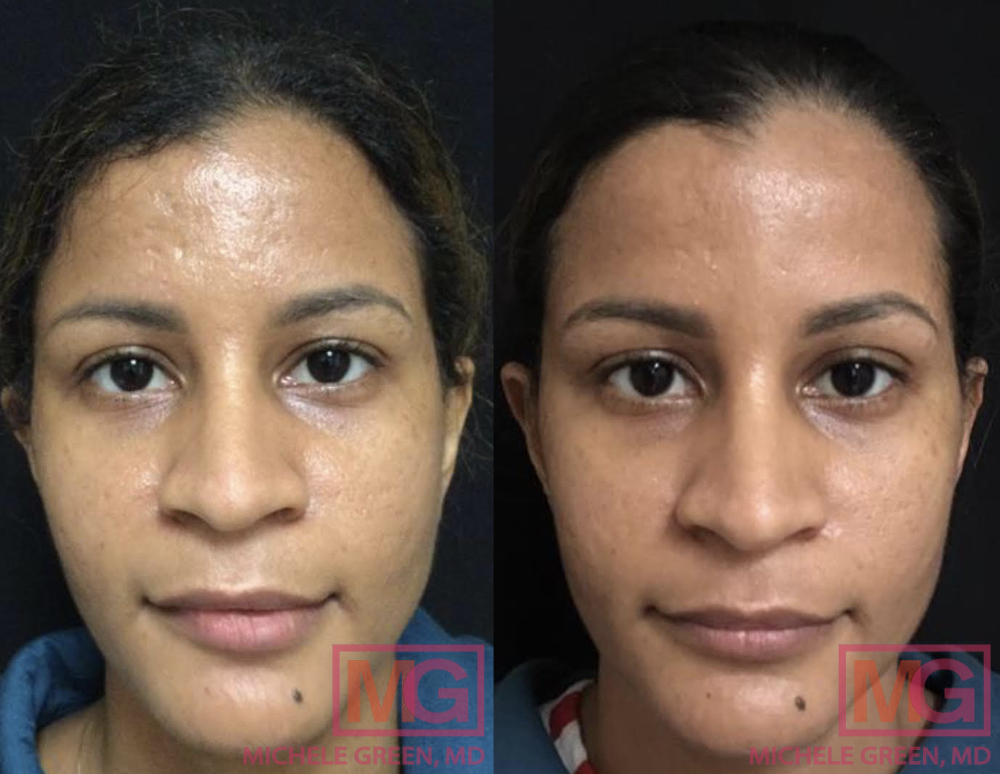
Will lasers improve acne scars?
Yes, Dr. Green employs many lasers which can improve the appearance of acne scars. Laser resurfacing treatment for acne scar removal primarily works by stimulating new collagen production in the skin through the induction of the natural wound healing process. Collagen is a protein naturally found in the skin and contributes to a smooth, firm texture. By creating new collagen, laser resurfacing treatment effectively improves the skin’s texture and reduces the appearance of acne scars.
Can CO2 laser remove acne scars?
Ablative skin resurfacing laser treatments, including carbon dioxide (CO2) lasers and erbium YAG lasers, remove the entire outer layer of skin in the treatment area. The damaged skin of this outer layer is eliminated to reveal fresh, healthy skin beneath. At the same time, the laser heats the underlying dermal layer of the skin, stimulating new collagen production in the treated area. CO2 lasers promote collagen remodeling, improve skin tone and texture, and tighten the skin, making them commonly used for treating deeper lines and wrinkles. This laser treatment is more aggressive than non-ablative lasers, such as the Fraxel laser, and requires significantly more downtime. In contrast, non-ablative skin resurfacing lasers like Fraxel create precise and controlled micro-injuries to the targeted area while leaving the surrounding skin untouched, without removing the top layer of skin as ablative lasers do. Consequently, CO2 laser treatments and other ablative skin resurfacing lasers involve significantly more downtime compared to non-ablative options like Fraxel, which is why many patients prefer Fraxel over CO2.
How much does acne scar and acne laser treatment cost?
Several factors influence the total cost of your non-ablative laser resurfacing treatment for acne and acne scars. The cost of laser treatment depends on various aspects, including the experience level of the board-certified dermatologist or plastic surgeon performing the procedure, the geographic location of the office where the treatment occurs, the selected laser, and the number of sessions required to achieve your ideal skin rejuvenation results. Although it may be less expensive to undergo laser skin resurfacing in a medical spa, the risk of experiencing unwanted side effects—such as burning, skin discoloration, and even scarring—significantly increases if a board-certified expert does not perform the procedure. Another factor influencing cost is the number of sessions needed to attain the desired cosmetic results.
Unfortunately, it is impossible to predict how many sessions an individual will require, as each patient responds uniquely to laser treatment. Some individuals see remarkable results after a single session, while others may need up to five sessions to achieve improved skin texture. The severity of acne and acne scarring also affects the total number of sessions required, ultimately influencing the final cost of treatment. Choosing an experienced dermatologist like Dr. Michele Green is crucial. She has extensive expertise in laser treatments and can accurately determine which option is best for your skin tone, type, and concerns. During your consultation, Dr. Green will collaborate with you to identify laser treatments and other cosmetic procedures that align with your needs and goals. At that point, she will provide the estimated cost of your laser treatment plan.
Is acne scar and acne laser treatment worth it?
Yes! Acne laser treatment can be an excellent complementary option for those dealing with breakouts. It is often recommended to use other treatment modalities, such as topical treatments or oral medications, simultaneously to achieve optimal results. Furthermore, for many patients who have faced acne breakouts, reducing the appearance of their acne scars with laser treatment is definitely worthwhile. The visibility of breakouts and acne scars can significantly impact feelings of self-consciousness and low self-esteem. Undergoing laser treatment for acne breakouts and scars is an investment in self-care that many patients find extremely valuable, as it helps restore their confidence and allows them to look and feel their best. When you consult with Dr. Green for your laser treatments, she will collaborate with you to create a personalized plan that addresses your specific concerns and goals.
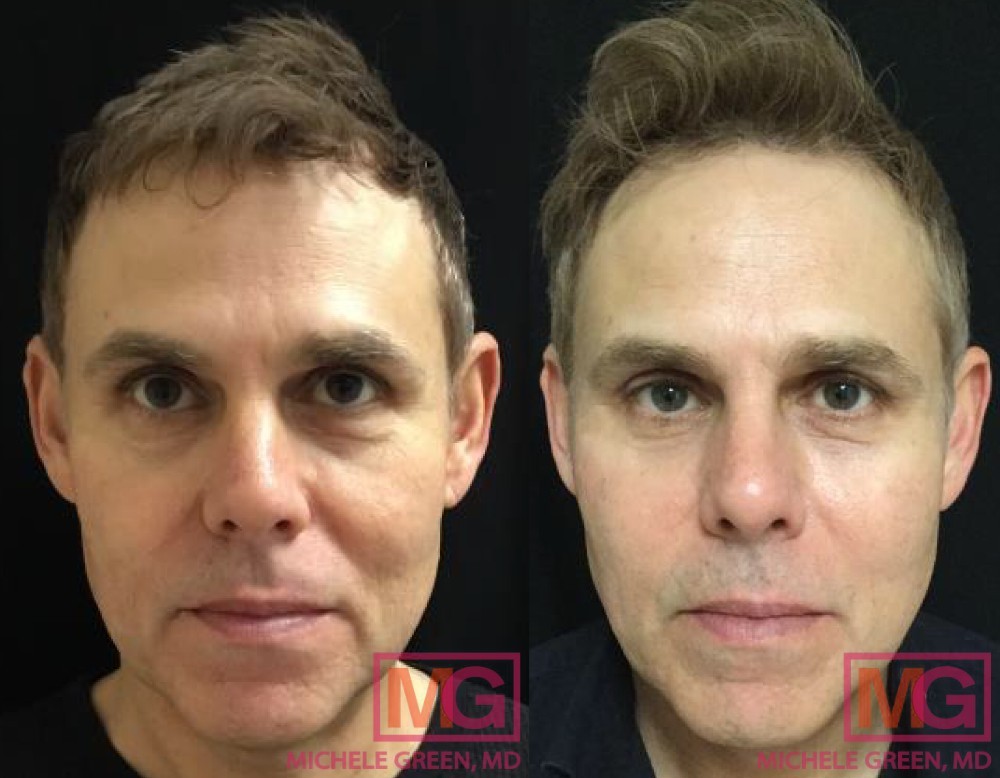
How do I get started with acne scar and acne laser treatment today?
While acne breakouts and scars are common skin conditions, their presence can lead to feelings of self-consciousness and low self-esteem for many. However, it is possible to permanently eliminate pimples and significantly reduce the appearance of acne scars through laser treatments. These treatments utilize various types of light and energy to address breakouts and scars with little to no downtime or side effects. At her private dermatology office in NYC, Dr. Green offers numerous non-invasive options, including lasers such as Fraxel, eMatrix, Vbeam, and Photodynamic therapy, to promote healthy, radiant, and clear skin. As an expert in cosmetic dermatology, Dr. Green partners with you to create a customized treatment plan for acne and acne scars that targets your skin concerns, delivering a healthy, smooth, clear, and beautiful complexion that endures.
Dr. Michele Green is an internationally recognized, board-certified cosmetic dermatologist with over 25 years of experience providing non-invasive treatments for active breakouts and acne scars at her boutique office on Manhattan’s Upper East Side. Super Doctors, Castle Connolly, and New York Magazine consistently list Dr. Green as one of New York’s top physicians due to her commitment to patients and expertise. By employing the latest laser treatments and innovative skin resurfacing techniques, Dr. Green provides her patients with exceptional medical advice and recommends specially formulated skincare products for comprehensive care. When you choose to collaborate with Dr. Green on your active acne or scars, she will assist you in crafting a personalized treatment plan tailored to your unique skin condition for optimal results. To schedule a consultation with Dr. Green, call 212-535-3088 or contact us online today to commence your journey toward achieving a clear, smooth, and beautiful complexion that lasts.
Related Topics
- Learn about the Fraxel Dual Laser
- Platelet Rich Plasma therapy (PRP) & Micro-needling for acne
- Find out more about Clear + Brilliant
- Rosacea treatment with the V-Beam laser
- The eMatrix can be used for acne scars
- See how the Intense Pulsed Light (IPL) treatment can help
- More info about Acne Scar Treatment
 212-535-3088
212-535-3088 